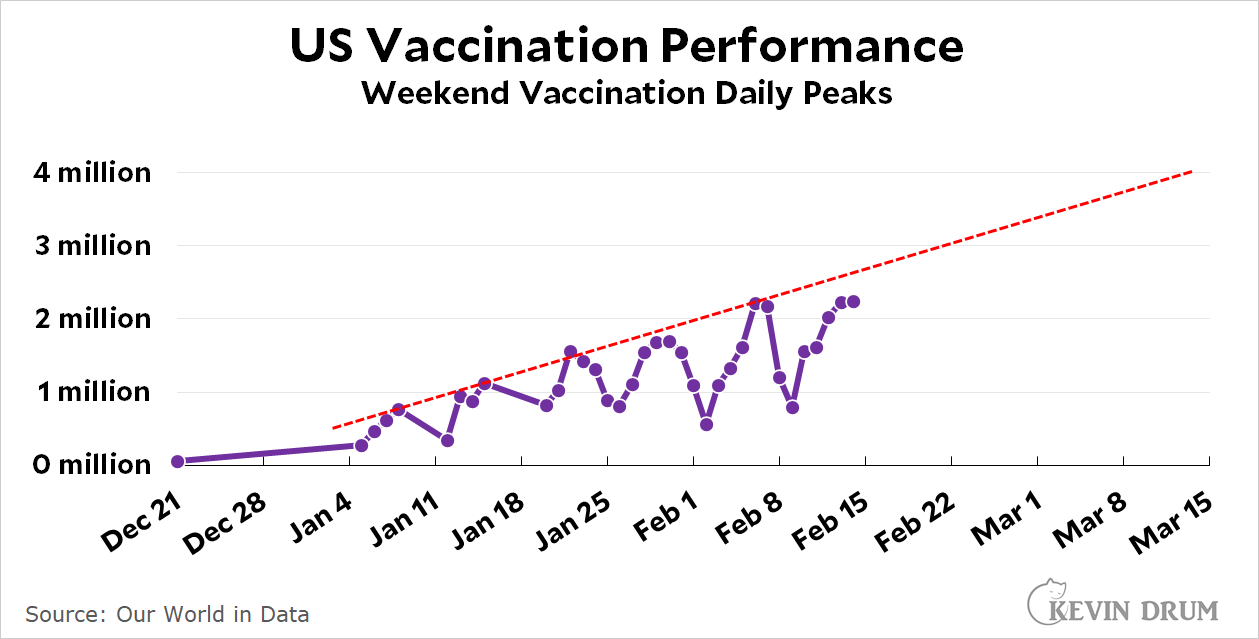I've said before that we will never make serious progress toward eliminating racism until Black students are educated on a par with white students. Half a century ago that would have been an uncontroversial statement, but after 50 years of trying and failing to close the Black-white education gap it's become tiresome to many people, little more than a cheap excuse for doing nothing. But tiresome or not, it's still a huge problem. Here's a chart that demonstrates the scope of what we're up against:
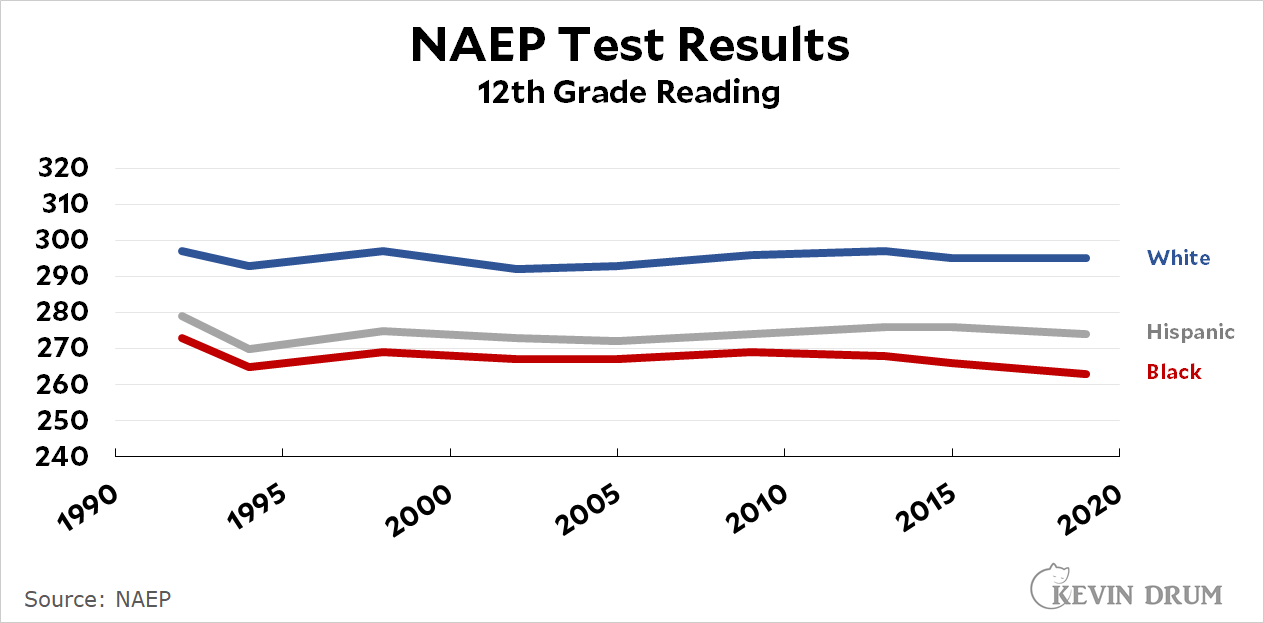
Black students who graduate from high school score about 30 points worse than white students on the NAEP reading test. Ditto for the math test. That's roughly three grade levels, which means that, on average, Black high school grads perform at about the same level as 9th grade white students. And this hasn't gotten any better over the past 30 years. In fact, it's gotten worse.
This is bad enough on its own. But it turns out that education is associated with a host of other problems. Not every problem, but a lot of them. Today I want to go through a few of them in an effort to persuade you to join the education cause. The evidence isn't perfect—in the real world it never is—but it's surprisingly consistent.
Income
About a decade ago Jay Zagorsky, then at Ohio State, wrote a paper comparing the incomes of various educational groups. He used the language of IQ because that was the data available to him, but don't let that throw you: An IQ of 85 is roughly equivalent to an 18-year-old performing like someone three grade levels lower. What Zagorsky found was simple: that person earned about 25% less than a person performing at age level. And according to recent census figures, the median income of Black workers is 21% lower than white workers.
Put these numbers together with the NAEP test results and they suggest that the average Black worker (a) performs at about the same level as a white worker with a 9th grade education, and (b) earns about as much as a white worker with a 9th grade education.
And of course there's a corollary: Education is also tightly bound up with Black wealth, both directly (higher income ---> higher wealth) and indirectly (higher income ---> higher death bequests and higher inheritances). There are other things that affect Black wealth too, but education is clearly one of the strongest.
Unemployment
As we all know, the unemployment rate of Black workers is substantially higher than it is for white workers:
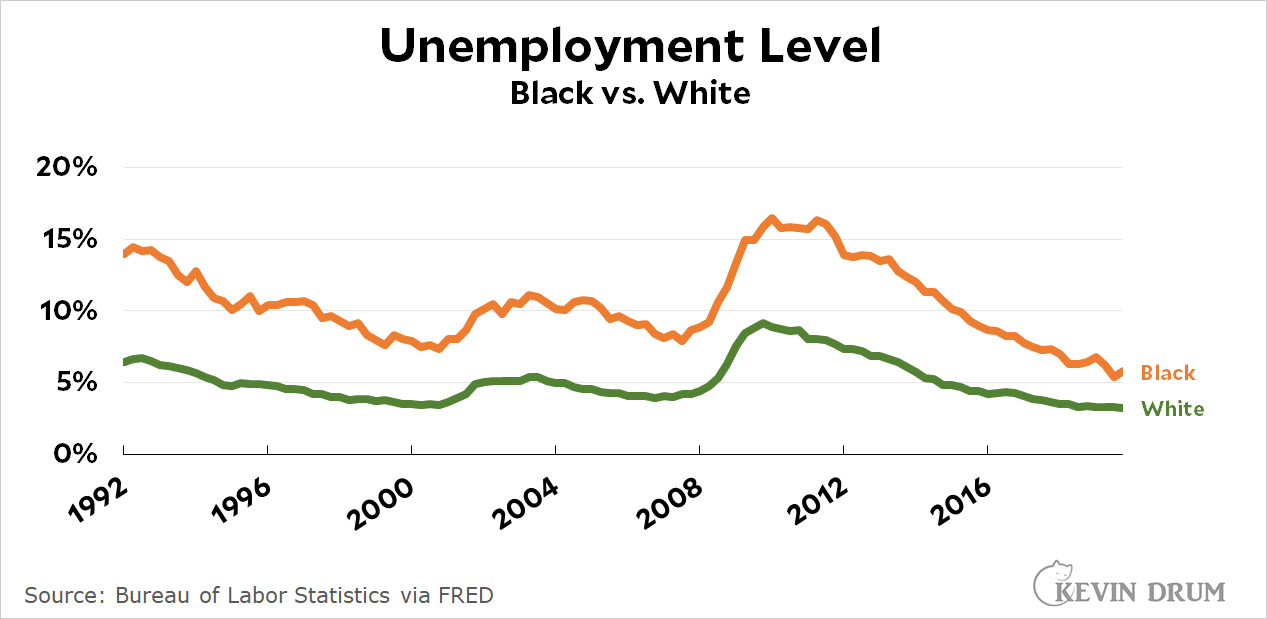
On average over the past three decades, the Black unemployment rate is about five points higher than the white unemployment rate. But take a look at this:

When you compare the unemployment rate for Black workers to the unemployment rate of all high school dropouts, the difference almost disappears. Once again, the average Black worker is being treated like a white worker with roughly a 9th grade education.
Incarceration
Moving on from jobs-related research, here's a paper that looks at incarceration. The main result is shown in this pair of charts:
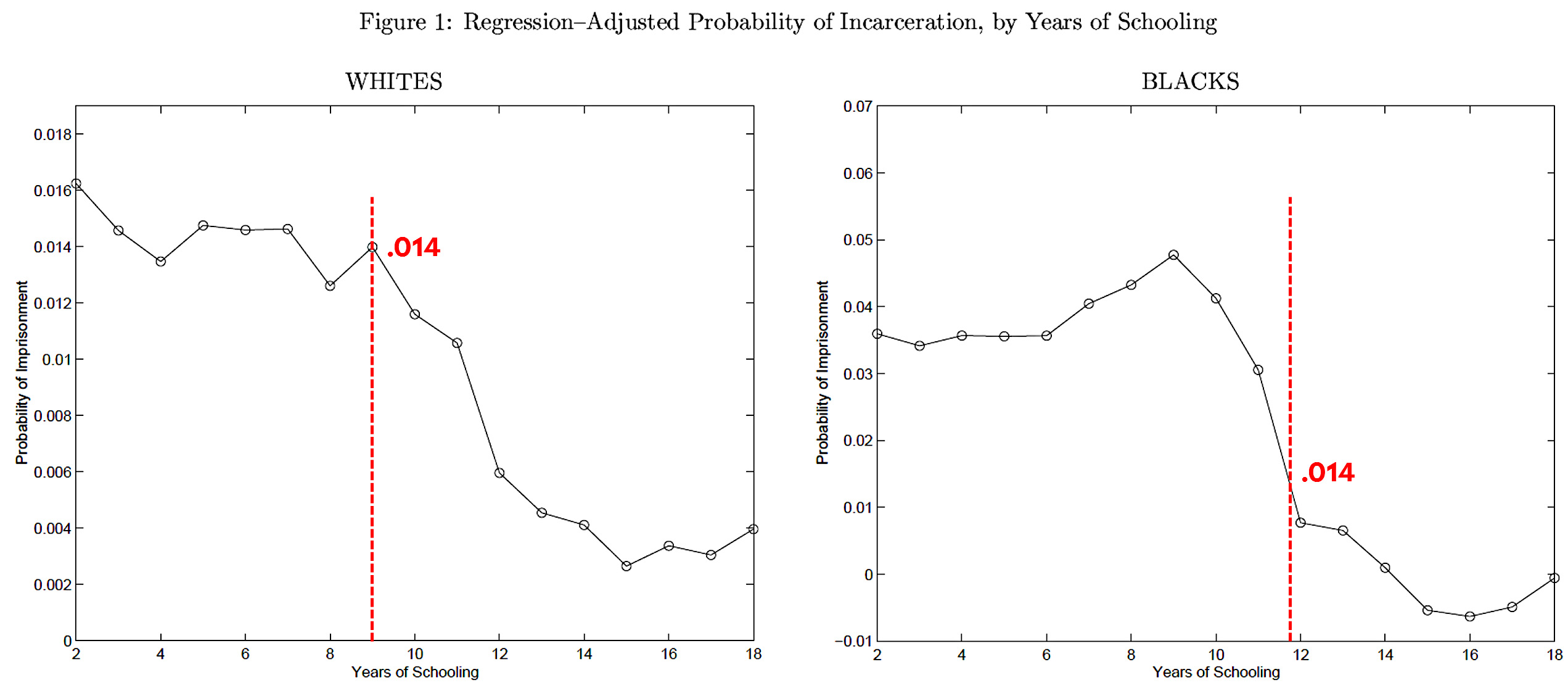
White people with a 9th grade education are incarcerated at the same rate as Black people who are just shy of a 12th grade education. These numbers plummet so steeply between 9th and 12th grade that they aren't very precise, but once again we find that the average Black person with a 12th grade education is treated very much like a white person with a 9th grade education.
Life Expectancy
This one is interesting. Here's a table from a study of life expectancy by educational level:
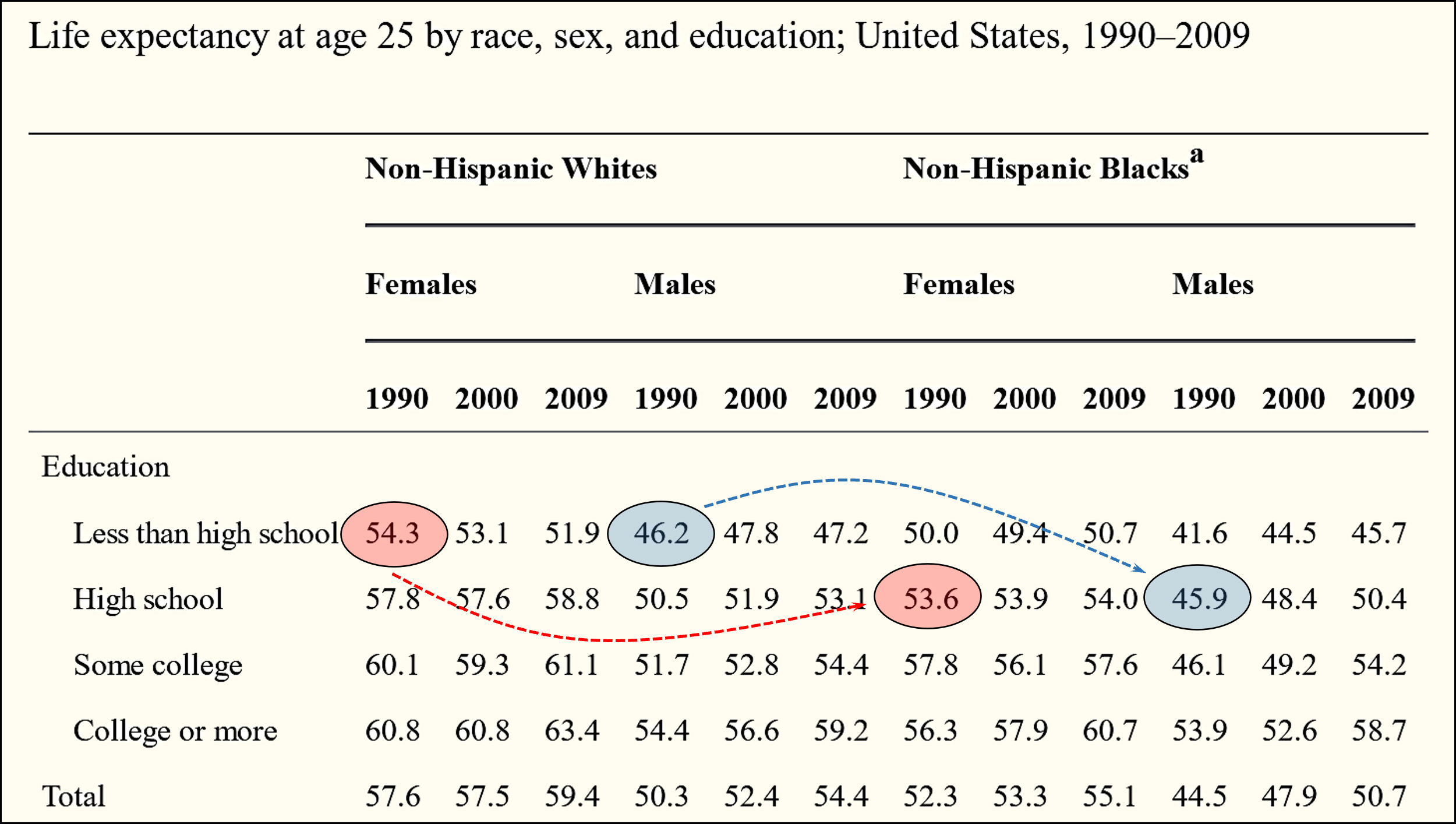
Back in 1990, the life expectancy of Black people with a high school diploma was almost identical to that of white people who had dropped out of high school. This is very much in keeping with our thesis.
Interestingly, things have changed since then. White women with no high school diploma have lost nearly three years of life expectancy while Black men with a high school diploma have added about four year of life expectancy. Put together, it means that Black people with a high school diploma are now doing a bit better than white people who dropped out.
This is evidence that things can change even without a change in educational differences. Education has a big impact, but it's not everything.
Children's Health
This one is a little tricky because, obviously, it can't be based on the child's education. However, it can be measured relative to parental education. Here's the chart:
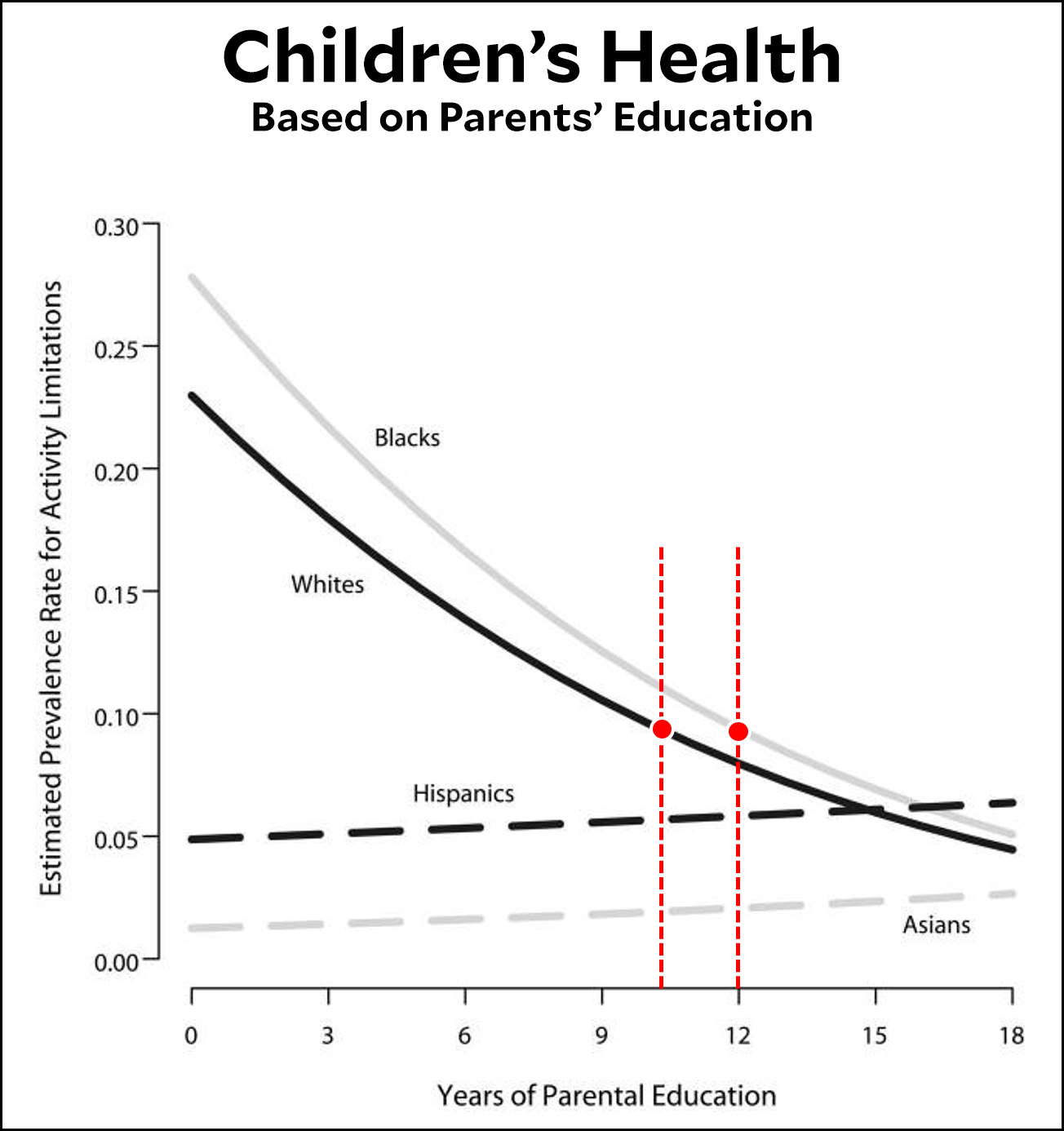
The red dot on the gray line shows the health of Black children whose parents have a high school education. (Poor health is indicated by having "activity and school limitations.") It's equivalent to the health of a white child whose parents have about a 10th grade education.
Summary
Nobody claims that education is the sole determinant of Black well-being. Studies over the years have consistently found that even after you adjust for education there's still a significant residual effect due solely to being Black. Most often, the residual is the impact of straight-up bigotry, both personal and systemic.
What's more, the evidence I've presented here isn't 100% consistent. It never is in the real world. In most of the studies the effect of education has stayed constant over the years, while in the case of life expectancy Black men have made large improvements. Sometimes a Black person with a 12th grade education is equivalent to a white person with a 9th grade education, while in others it's closer to a 10th grade education.
And of course there's a famously circular argument to address: We know that poor education is one of the causes of poverty, but we also know that poverty (especially concentrated poverty) is one of the causes of poor education. Which is the chicken and which is the egg? I think the evidence is fairly clear that education is the primal cause here, but there are plausible arguments in the other direction.
Taken as a whole, the evidence is strong that Black people in the US who graduate from high school perform, on average, at about a 9th grade level and have outcomes that are similar to white people with a 9th grade education. What's more, this disparate performance starts long before high school. Some of it is visible by kindergarten or earlier, and the full effect is generally in place by the end of elementary school. To close the gap, we need to address it as early as pre-K and keep it up all the way through the end of high school.
Our inability to educate Black kids as well as we do white kids is one of our great national shames, and until we turn this around there's no chance of making substantial progress on the racial equality front. It's the frustrating but necessary minimum effort necessary for anyone who's serious about fighting racism.












 And that's if you have two children. If you're one of the even more hated "welfare moms" with a brood of four kids, you'd receive upwards of $15,000 per year. There's no time limit on these payments and no incentives to get a job. In fact, by reducing the EITC and the childcare tax credit, Romney's plan reduces the incentive to find a job.
And that's if you have two children. If you're one of the even more hated "welfare moms" with a brood of four kids, you'd receive upwards of $15,000 per year. There's no time limit on these payments and no incentives to get a job. In fact, by reducing the EITC and the childcare tax credit, Romney's plan reduces the incentive to find a job. Fascist. Even among scholars there's disagreement about exactly what fascism is. Among everyone else, it seems to mean nothing more than some kind of meanspirited attitude trumpeted by a Republican politician. That's really not very helpful. Not every hardcore conservative represents the second coming of Mussolini.
Fascist. Even among scholars there's disagreement about exactly what fascism is. Among everyone else, it seems to mean nothing more than some kind of meanspirited attitude trumpeted by a Republican politician. That's really not very helpful. Not every hardcore conservative represents the second coming of Mussolini.